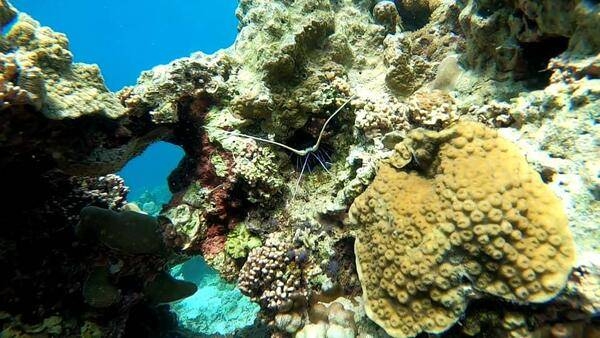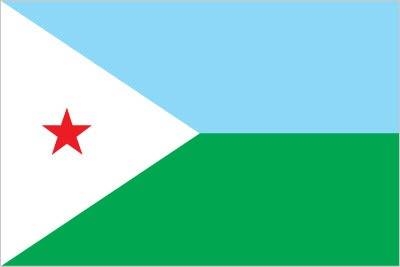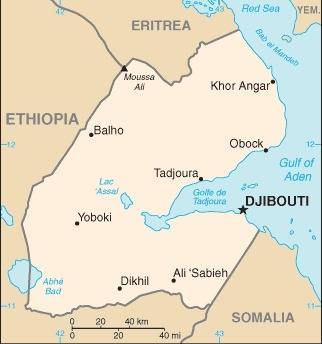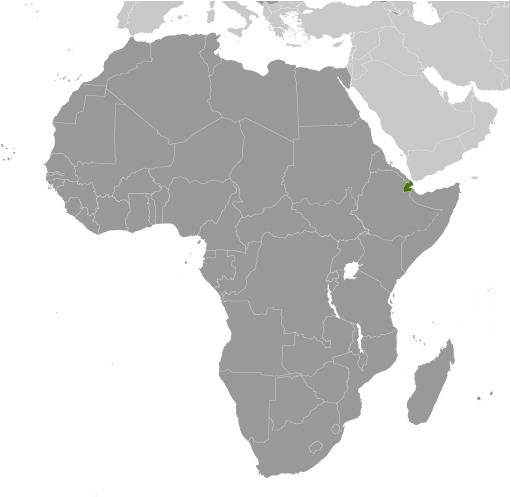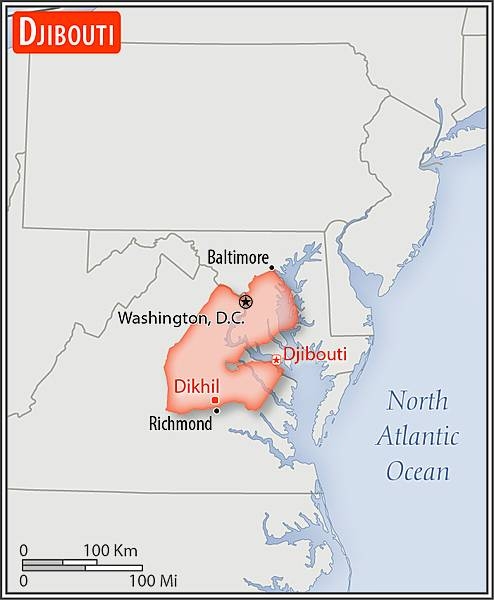Djibouti
Introduction
Background
The region of present-day Djibouti was the site of the medieval Ifat and Adal Sultanates. In the late 19th century, treaties signed by the Afar sultans with the French allowed the latter to establish the colony of French Somaliland in 1862. The French signed additional treaties with the ethnic Somali in 1885.
Tension between the ethnic Afar and Somali populations increased over time, as the ethnic Somalis perceived that the French unfairly favored the Afar and gave them disproportionate influence in local governance. In 1958, the French held a referendum that provided residents of French Somaliland the option to either continue their association with France or to join neighboring Somalia as it established its independence. The ethnic Somali protested the vote, because French colonial leaders did not recognize many Somali as residents, which gave the Afar outsized influence in the decision to uphold ties with France. After a second referendum in 1967, the French changed the territory’s name to the French Territory of the Afars and the Issas, in part to underscore their relationship with the ethnic Afar and downplay the significance of the ethnic Somalis. A final referendum in 1977 established Djibouti as an independent nation and granted ethnic Somalis Djiboutian nationality, formally resetting the balance of power between the majority ethnic Somalis and minority ethnic Afar residents. Upon independence, the country was named after its capital city of Djibouti. Hassan Gouled APTIDON, an ethnic Somali leader, installed an authoritarian one-party state and proceeded to serve as president until 1999. Unrest between the Afar minority and Somali majority culminated in a civil war during the 1990s that ended in 2001 with a peace accord between Afar rebels and the Somali Issa-dominated government. In 1999, Djibouti's first multiparty presidential election resulted in the election of Ismail Omar GUELLEH as president; he was reelected to a second term in 2005 and extended his tenure in office via a constitutional amendment, which allowed him to serve his third and fourth terms, and to begin a fifth term in 2021.Djibouti occupies a strategic geographic location at the intersection of the Red Sea and the Gulf of Aden. Its ports handle 95% of Ethiopia’s trade. Djibouti’s ports also service transshipments between Europe, the Middle East, and Asia. The government holds longstanding ties to France, which maintains a military presence in the country, as does the US, Japan, Italy, Germany, Spain, and China.
Visit the Definitions and Notes page to view a description of each topic.
Geography
Location
Eastern Africa, bordering the Gulf of Aden and the Red Sea, between Eritrea and Somalia
Geographic coordinates
11 30 N, 43 00 E
Map references
Africa
Land boundaries
total: 528 km
border countries (3): Eritrea 125 km; Ethiopia 342 km; Somalia 61 km
Coastline
314 km
Maritime claims
territorial sea: 12 nm
contiguous zone: 24 nm
exclusive economic zone: 200 nm
Climate
desert; torrid, dry
Terrain
coastal plain and plateau separated by central mountains
Elevation
highest point: Moussa Ali 2,021 m
lowest point: Lac Assal -155 m
mean elevation: 430 m
Natural resources
potential geothermal power, gold, clay, granite, limestone, marble, salt, diatomite, gypsum, pumice, petroleum
Land use
agricultural land: 73.4% (2018 est.)
arable land: 0.1% (2018 est.)
permanent crops: 0% (2018 est.)
permanent pasture: 73.3% (2018 est.)
forest: 0.2% (2018 est.)
other: 26.4% (2018 est.)
Irrigated land
10 sq km (2012)
Major lakes (area sq km)
salt water lake(s): Abhe Bad/Abhe Bid Hayk (shared with Ethiopia) - 780 sq km
Population distribution
most densely populated areas are in the east; the largest city is Djibouti, with a population over 600,000; no other city in the country has a total population over 50,000 as shown in this population distribution map
Natural hazards
earthquakes; droughts; occasional cyclonic disturbances from the Indian Ocean bring heavy rains and flash floods
volcanism: experiences limited volcanic activity; Ardoukoba (298 m) last erupted in 1978; Manda-Inakir, located along the Ethiopian border, is also historically active
Geography - note
strategic location near world's busiest shipping lanes and close to Arabian oilfields; terminus of rail traffic into Ethiopia; mostly wasteland; Lac Assal (Lake Assal) is the lowest point in Africa and the saltiest lake in the world
People and Society
Nationality
noun: Djiboutian(s)
adjective: Djiboutian
Ethnic groups
Somali 60%, Afar 35%, other 5% (mostly Yemeni Arab, also French, Ethiopian, and Italian)
Languages
French (official), Arabic (official), Somali, Afar
Religions
Sunni Muslim 94% (nearly all Djiboutians), other 6% (mainly foreign-born residents - Shia Muslim, Christian, Hindu, Jewish, Baha'i, and atheist)
Demographic profile
Djibouti is a poor, predominantly urban country, characterized by high rates of illiteracy, unemployment, and childhood malnutrition. More than 75% of the population lives in cities and towns (predominantly in the capital, Djibouti). The rural population subsists primarily on nomadic herding. Prone to droughts and floods, the country has few natural resources and must import more than 80% of its food from neighboring countries or Europe. Health care, particularly outside the capital, is limited by poor infrastructure, shortages of equipment and supplies, and a lack of qualified personnel. More than a third of health care recipients are migrants because the services are still better than those available in their neighboring home countries. The nearly universal practice of female genital cutting reflects Djibouti’s lack of gender equality and is a major contributor to obstetrical complications and its high rates of maternal and infant mortality. A 1995 law prohibiting the practice has never been enforced.
Because of its political stability and its strategic location at the confluence of East Africa and the Gulf States along the Gulf of Aden and the Red Sea, Djibouti is a key transit point for migrants and asylum seekers heading for the Gulf States and beyond. Each year some 100,000 people, mainly Ethiopians and some Somalis, journey through Djibouti, usually to the port of Obock, to attempt a dangerous sea crossing to Yemen. However, with the escalation of the ongoing Yemen conflict, Yemenis began fleeing to Djibouti in March 2015, with almost 20,000 arriving by August 2017. Most Yemenis remain unregistered and head for Djibouti City rather than seeking asylum at one of Djibouti’s three spartan refugee camps. Djibouti has been hosting refugees and asylum seekers, predominantly Somalis and lesser numbers of Ethiopians and Eritreans, at camps for 20 years, despite lacking potable water, food shortages, and unemployment.
Age structure
0-14 years: 29.97% (male 138,701/female 137,588)
15-24 years: 20.32% (male 88,399/female 98,955)
25-54 years: 40.73% (male 156,016/female 219,406)
55-64 years: 5.01% (male 19,868/female 26,307)
65 years and over: 3.97% (male 16,245/female 20,319) (2020 est.)
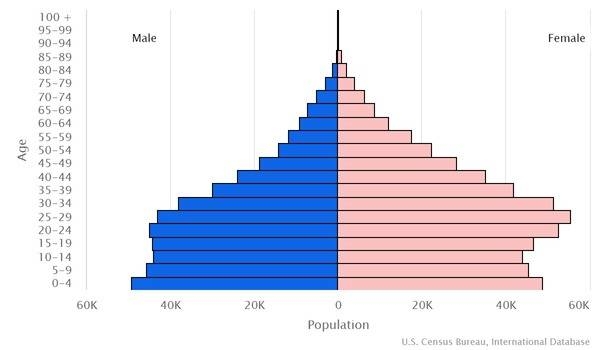
Dependency ratios
total dependency ratio: 50.6
youth dependency ratio: 47.5
elderly dependency ratio: 6.9
potential support ratio: 14.4 (2021 est.)
Median age
total: 24.9 years
male: 23 years
female: 26.4 years (2020 est.)
Population distribution
most densely populated areas are in the east; the largest city is Djibouti, with a population over 600,000; no other city in the country has a total population over 50,000 as shown in this population distribution map
Urbanization
urban population: 78.6% of total population (2023)
rate of urbanization: 1.56% annual rate of change (2020-25 est.)
Major urban areas - population
600,000 DJIBOUTI (capital) (2023)
Sex ratio
at birth: 1.03 male(s)/female
0-14 years: 1.01 male(s)/female
15-24 years: 0.9 male(s)/female
25-54 years: 0.7 male(s)/female
55-64 years: 0.72 male(s)/female
65 years and over: 0.65 male(s)/female
total population: 0.83 male(s)/female (2022 est.)
Maternal mortality ratio
248 deaths/100,000 live births (2017 est.)
country comparison to the world: 43Infant mortality rate
total: 46.89 deaths/1,000 live births
male: 54.14 deaths/1,000 live births
female: 39.43 deaths/1,000 live births (2022 est.)
Life expectancy at birth
total population: 65.3 years
male: 62.72 years
female: 67.96 years (2022 est.)
Contraceptive prevalence rate
19% (2012)
Drinking water source
improved: urban: 99.7% of population
rural: 59.3% of population
total: 90.8% of population
unimproved: urban: 0.3% of population
rural: 40.7% of population
total: 9.2% of population (2020 est.)
Current health expenditure
1.8% of GDP (2019)
Physicians density
0.22 physicians/1,000 population (2014)
Hospital bed density
1.4 beds/1,000 population (2017)
Sanitation facility access
improved: urban: 87.7% of population
rural: 24.2% of population
total: 73.8% of population
unimproved: urban: 12.3% of population
rural: 75.8% of population
total: 26.2% of population (2020 est.)
Major infectious diseases
degree of risk: high (2020)
food or waterborne diseases: bacterial and protozoal diarrhea, hepatitis A, and typhoid fever
vectorborne diseases: dengue fever
note: on 21 March 2022, the US Centers for Disease Control and Prevention (CDC) issued a Travel Alert for polio in Africa; Djibouti is currently considered a high risk to travelers for circulating vaccine-derived polioviruses (cVDPV); vaccine-derived poliovirus (VDPV) is a strain of the weakened poliovirus that was initially included in oral polio vaccine (OPV) and that has changed over time and behaves more like the wild or naturally occurring virus; this means it can be spread more easily to people who are unvaccinated against polio and who come in contact with the stool or respiratory secretions, such as from a sneeze, of an “infected” person who received oral polio vaccine; the CDC recommends that before any international travel, anyone unvaccinated, incompletely vaccinated, or with an unknown polio vaccination status should complete the routine polio vaccine series; before travel to any high-risk destination, the CDC recommends that adults who previously completed the full, routine polio vaccine series receive a single, lifetime booster dose of polio vaccine
Alcohol consumption per capita
total: 0.21 liters of pure alcohol (2019 est.)
beer: 0.05 liters of pure alcohol (2019 est.)
wine: 0.02 liters of pure alcohol (2019 est.)
spirits: 0.14 liters of pure alcohol (2019 est.)
other alcohols: 0 liters of pure alcohol (2019 est.)
Literacy
total population: NA
male: NA
female: NA
School life expectancy (primary to tertiary education)
total: 7 years
male: 7 years
female: 7 years (2011)
Youth unemployment rate (ages 15-24)
total: 73%
male: 72%
female: 74.6% (2017)
Environment
Environment - current issues
inadequate supplies of potable water; water pollution; limited arable land; deforestation (forests threatened by agriculture and the use of wood for fuel); desertification; endangered species
Environment - international agreements
party to: Biodiversity, Climate Change, Climate Change-Kyoto Protocol, Climate Change-Paris Agreement, Comprehensive Nuclear Test Ban, Desertification, Endangered Species, Hazardous Wastes, Law of the Sea, Ozone Layer Protection, Ship Pollution, Wetlands
signed, but not ratified: none of the selected agreements
Air pollutants
particulate matter emissions: 40.38 micrograms per cubic meter (2016 est.)
carbon dioxide emissions: 0.62 megatons (2016 est.)
methane emissions: 0.52 megatons (2020 est.)
Climate
desert; torrid, dry
Land use
agricultural land: 73.4% (2018 est.)
arable land: 0.1% (2018 est.)
permanent crops: 0% (2018 est.)
permanent pasture: 73.3% (2018 est.)
forest: 0.2% (2018 est.)
other: 26.4% (2018 est.)
Urbanization
urban population: 78.6% of total population (2023)
rate of urbanization: 1.56% annual rate of change (2020-25 est.)
Revenue from forest resources
forest revenues: 0.26% of GDP (2018 est.)
country comparison to the world: 86Major infectious diseases
degree of risk: high (2020)
food or waterborne diseases: bacterial and protozoal diarrhea, hepatitis A, and typhoid fever
vectorborne diseases: dengue fever
note: on 21 March 2022, the US Centers for Disease Control and Prevention (CDC) issued a Travel Alert for polio in Africa; Djibouti is currently considered a high risk to travelers for circulating vaccine-derived polioviruses (cVDPV); vaccine-derived poliovirus (VDPV) is a strain of the weakened poliovirus that was initially included in oral polio vaccine (OPV) and that has changed over time and behaves more like the wild or naturally occurring virus; this means it can be spread more easily to people who are unvaccinated against polio and who come in contact with the stool or respiratory secretions, such as from a sneeze, of an “infected” person who received oral polio vaccine; the CDC recommends that before any international travel, anyone unvaccinated, incompletely vaccinated, or with an unknown polio vaccination status should complete the routine polio vaccine series; before travel to any high-risk destination, the CDC recommends that adults who previously completed the full, routine polio vaccine series receive a single, lifetime booster dose of polio vaccine
Food insecurity
widespread lack of access: due to unfavorable weather and high food prices - about 192,000 people are estimated to be experiencing acute food insecurity between July and December 2022 mainly due to insufficient rains in 2021 and 2022, which affected rangelands and pastoral livelihoods, and high food prices (2022)
Waste and recycling
municipal solid waste generated annually: 114,997 tons (2002 est.)
Major lakes (area sq km)
salt water lake(s): Abhe Bad/Abhe Bid Hayk (shared with Ethiopia) - 780 sq km
Total water withdrawal
municipal: 16 million cubic meters (2017 est.)
industrial: 0 cubic meters (2017 est.)
agricultural: 3 million cubic meters (2017 est.)
Total renewable water resources
300 million cubic meters (2017 est.)
Government
Country name
conventional long form: Republic of Djibouti
conventional short form: Djibouti
local long form: Republique de Djibouti (French)/ Jumhuriyat Jibuti (Arabic)
local short form: Djibouti (French)/ Jibuti (Arabic)
former: French Somaliland, French Territory of the Afars and Issas
etymology: the country name derives from the capital city of Djibouti
Government type
presidential republic
Capital
name: Djibouti
geographic coordinates: 11 35 N, 43 09 E
time difference: UTC+3 (8 hours ahead of Washington, DC, during Standard Time)
etymology: the origin of the name is disputed; multiple descriptions, possibilities, and theories have been proposed
Administrative divisions
6 districts (cercles, singular - cercle); Ali Sabieh, Arta, Dikhil, Djibouti, Obock, Tadjourah
Independence
27 June 1977 (from France)
National holiday
Independence Day, 27 June (1977)
Constitution
history: approved by referendum 4 September 1992
amendments: proposed by the president of the republic or by the National Assembly; Assembly consideration of proposals requires assent of at least one third of the membership; passage requires a simple majority vote by the Assembly and approval by simple majority vote in a referendum; the president can opt to bypass a referendum if adopted by at least two-thirds majority vote of the Assembly; constitutional articles on the sovereignty of Djibouti, its republican form of government, and its pluralist form of democracy cannot be amended; amended 2006, 2008, 2010
Legal system
mixed legal system based primarily on the French civil code (as it existed in 1997), Islamic religious law (in matters of family law and successions), and customary law
International law organization participation
accepts compulsory ICJ jurisdiction with reservations; accepts ICCt jurisdiction
Citizenship
citizenship by birth: no
citizenship by descent only: the mother must be a citizen of Djibouti
dual citizenship recognized: no
residency requirement for naturalization: 10 years
Suffrage
18 years of age; universal
Executive branch
chief of state: President Ismail Omar GUELLEH (since 8 May 1999)
head of government: Prime Minister Abdoulkader Kamil MOHAMED (since 1 April 2013)
cabinet: Council of Ministers appointed by the prime minister
elections/appointments: president directly elected by absolute majority popular vote in 2 rounds if needed for a 5-year term; election last held on 9 April 2021 (next to be held in April 2026); prime minister appointed by the president
election results: 2021: Ismail Omar GUELLEH reelected president for a fifth term; percent of vote - Ismail Omar GUELLEH (RPP) 97.4%, Zakaria Ismael FARAH (MDEND) 2.7%
2016: Ismail Omar GUELLEH reelected president for a fourth term; percent of vote - Ismail Omar GUELLEH (RPP) 87%, Omar Elmi KHAIREH (CDU) 7.3%, other 5.6%
Legislative branch
description: unicameral National Assembly or Assemblee Nationale, formerly the Chamber of Deputies (65 seats; members directly elected in multi-seat constituencies by party-list proportional representation vote; members serve 5-year terms)
elections: last held on 23 February 2018 (next to be held in February 2023)
election results: percent of vote by party - NA; seats by party - UMP 57, UDJ-PDD 7, CDU 1; composition - men 48, women 17, percent of women 26.2%
Judicial branch
highest court(s): Supreme Court or Cour Supreme (consists of NA magistrates); Constitutional Council (consists of 6 magistrates)
judge selection and term of office: Supreme Court magistrates appointed by the president with the advice of the Superior Council of the Magistracy (CSM), a 10-member body consisting of 4 judges, 3 members (non parliamentarians and judges) appointed by the president, and 3 appointed by the National Assembly president or speaker; magistrates appointed for life with retirement at age 65; Constitutional Council magistrate appointments - 2 by the president of the republic, 2 by the president of the National Assembly, and 2 by the CSM; magistrates appointed for 8-year, non-renewable terms
subordinate courts: High Court of Appeal; 5 Courts of First Instance; customary courts; State Court (replaced sharia courts in 2003)
Political parties and leaders
Center for United Democrats or CDU [Ahmed Mohamed YOUSSOUF, chairman]
Democratic Renewal Party or PRD [Abdillahi HAMARITEH]
Djibouti Development Party or PDD [Mohamed Daoud CHEHEM]
Front for Restoration of Unity and Democracy (Front pour la Restauration de l'Unite Democratique) or FRUD [Ali Mohamed DAOUD]
Movement for Democratic Renewal and Development or MRD (formerly Democratic Renewal Party or PRD) [Daher Ahmed FARAH]
National Democratic Party or PND [Aden Robleh AWALEH]
People's Rally for Progress or RPP [Ismail Omar GUELLEH] (governing party)
Peoples Social Democratic Party or PPSD [Hasna Moumin BAHDON]
Republican Alliance for Democracy or ARD [Aden Mohamed ABDOU]
Union for Democracy and Justice or UDJ [Ilya Ismail GUEDI Hared]
Union for the Presidential Majority coalition or UMP [collective leadership] (electoral coalition includes RPP, FRUD, PPSD, and UPR)
Union for National Salvation coalition or USN [collective leadership] (electoral coalition includes ARD, PRD, PDD, UDJ, and PND)
Union of Reform Partisans or UPR [Ibrahim Daoud CHEHEM]
note: only parties with seats in the National Assembly included
International organization participation
ACP, AfDB, AFESD, AMF, ATMIS, AU, CAEU (candidates), COMESA, FAO, G-77, IBRD, ICAO, ICCt, ICRM, IDA, IDB, IFAD, IFC, IFRCS, IGAD, ILO, IMF, IMO, Interpol, IOC, IOM, IPU, ITU, ITUC (NGOs), LAS, MIGA, MINURSO, NAM, OIC, OIF, OPCW, UN, UNCTAD, UNESCO, UNHCR, UNIDO, UNWTO, UPU, WCO, WFTU (NGOs), WHO, WIPO, WMO, WTO
Diplomatic representation in the US
chief of mission: Ambassador Mohamed Siad DOUALEH (28 January 2016)
chancery: 1156 15th Street NW, Suite 515, Washington, DC 20005
telephone: [1] (202) 331-0270
FAX: [1] (202) 331-0302
email address and website:
info@djiboutiembassyus.org
https://www.djiboutiembassyus.org/
Diplomatic representation from the US
chief of mission: Ambassador Jonathan Goodale PRATT (since 22 February 2021)
embassy: Lot 350-B Haramouss, B.P. 185
mailing address: 2150 Djibouti Place, Washington DC 20521-2150
telephone: [253] 21-45-30-00
FAX: [253] 21-45-31-29
email address and website:
DjiboutiACS@state.gov
https://dj.usembassy.gov/
Flag description
two equal horizontal bands of light blue (top) and light green with a white isosceles triangle based on the hoist side bearing a red five-pointed star in the center; blue stands for sea and sky and the Issa Somali people; green symbolizes earth and the Afar people; white represents peace; the red star recalls the struggle for independence and stands for unity
National symbol(s)
red star; national colors: light blue, green, white, red
Economy
Economic overview
Djibouti's economy is based on service activities connected with the country's strategic location as a deepwater port on the Red Sea. Three-fourths of Djibouti's inhabitants live in the capital city; the remainder are mostly nomadic herders. Scant rainfall and less than 4% arable land limits crop production to small quantities of fruits and vegetables, and most food must be imported.
Djibouti provides services as both a transit port for the region and an international transshipment and refueling center. Imports, exports, and reexports represent 70% of port activity at Djibouti's container terminal. Reexports consist primarily of coffee from landlocked neighbor Ethiopia. Djibouti has few natural resources and little industry. The nation is, therefore, heavily dependent on foreign assistance to support its balance of payments and to finance development projects. An official unemployment rate of nearly 40% - with youth unemployment near 80% - continues to be a major problem. Inflation was a modest 3% in 2014-2017, due to low international food prices and a decline in electricity tariffs.
Djibouti’s reliance on diesel-generated electricity and imported food and water leave average consumers vulnerable to global price shocks, though in mid-2015 Djibouti passed new legislation to liberalize the energy sector. The government has emphasized infrastructure development for transportation and energy and Djibouti – with the help of foreign partners, particularly China – has begun to increase and modernize its port capacity. In 2017, Djibouti opened two of the largest projects in its history, the Doraleh Port and Djibouti-Addis Ababa Railway, funded by China as part of the "Belt and Road Initiative," which will increase the country’s ability to capitalize on its strategic location.
Real GDP (purchasing power parity)
$5.42 billion (2020 est.)
$5.39 billion (2019 est.)
$5 billion (2018 est.)
note: data are in 2017 dollars
Real GDP growth rate
6.7% (2017 est.)
6.5% (2016 est.)
6.5% (2015 est.)
Real GDP per capita
$5,500 (2020 est.)
$5,500 (2019 est.)
$5,200 (2018 est.)
note: data are in 2017 dollars
GDP (official exchange rate)
$3.323 billion (2019 est.)
GDP - composition, by sector of origin
agriculture: 2.4% (2017 est.)
industry: 17.3% (2017 est.)
services: 80.2% (2017 est.)
GDP - composition, by end use
household consumption: 56.5% (2017 est.)
government consumption: 29.2% (2017 est.)
investment in fixed capital: 41.8% (2017 est.)
investment in inventories: 0.3% (2017 est.)
exports of goods and services: 38.6% (2017 est.)
imports of goods and services: -66.4% (2017 est.)
Agricultural products
vegetables, milk, beef, camel milk, lemons, limes, goat meat, mutton, beans, tomatoes
Industries
construction, agricultural processing, shipping
Labor force - by occupation
agriculture: NA
industry: NA
services: NA
Youth unemployment rate (ages 15-24)
total: 73%
male: 72%
female: 74.6% (2017)
Population below poverty line
21.1% (2017 est.)
Gini Index coefficient - distribution of family income
41.6 (2017 est.)
country comparison to the world: 49Household income or consumption by percentage share
lowest 10%: 2.4%
highest 10%: 30.9% (2002)
Budget
revenues: 717 million (2017 est.)
expenditures: 899.2 million (2017 est.)
Fiscal year
calendar year
Current account balance
-$280 million (2017 est.)
-$178 million (2016 est.)
Exports
$5.15 billion (2019 est.) note: data are in current year dollars
$4.56 billion (2018 est.) note: data are in current year dollars
Exports - partners
Saudi Arabia 42%, India 15%, China 14%, Egypt 5%, South Korea 5% (2019)
Exports - commodities
various animals, chlorides, dried legumes, industrial fatty acids/oils, coffee, chickpeas (2019)
Imports
$4.76 billion (2019 est.) note: data are in current year dollars
$4.19 billion (2018 est.) note: data are in current year dollars
Imports - partners
China 43%, United Arab Emirates 15%, India 7%, Turkey 5% (2019)
Imports - commodities
refined petroleum, fertilizers, iron sheeting, cars, palm oil (2019)
Reserves of foreign exchange and gold
$547.7 million (31 December 2017 est.)
$398.5 million (31 December 2016 est.)
Debt - external
$1.954 billion (31 December 2017 est.)
$1.519 billion (31 December 2016 est.)
Exchange rates
Djiboutian francs (DJF) per US dollar -
177.7 (2017 est.)
177.72 (2016 est.)
177.72 (2015 est.)
177.72 (2014 est.)
177.72 (2013 est.)
Energy
Electricity access
electrification - total population: 42% (2019)
electrification - urban areas: 54% (2019)
electrification - rural areas: 1% (2019)
Electricity
installed generating capacity: 130,000 kW (2020 est.)
consumption: -62.6 million kWh (2019 est.)
exports: 0 kWh (2019 est.)
imports: 0 kWh (2019 est.)
transmission/distribution losses: 120 million kWh (2019 est.)
Electricity generation sources
fossil fuels: 98.2% of total installed capacity (2020 est.)
nuclear: 0% of total installed capacity (2020 est.)
solar: 1.8% of total installed capacity (2020 est.)
wind: 0% of total installed capacity (2020 est.)
hydroelectricity: 0% of total installed capacity (2020 est.)
tide and wave: 0% of total installed capacity (2020 est.)
geothermal: 0% of total installed capacity (2020 est.)
biomass and waste: 0% of total installed capacity (2020 est.)
Coal
production: 0 metric tons (2020 est.)
consumption: 0 metric tons (2020 est.)
exports: 0 metric tons (2020 est.)
imports: 0 metric tons (2020 est.)
proven reserves: 0 metric tons (2019 est.)
Petroleum
total petroleum production: 0 bbl/day (2021 est.)
refined petroleum consumption: 4,300 bbl/day (2019 est.)
crude oil and lease condensate exports: 0 bbl/day (2018 est.)
crude oil and lease condensate imports: 0 bbl/day (2018 est.)
crude oil estimated reserves: 0 barrels (2021 est.)
Natural gas
production: 0 cubic meters (2021 est.)
consumption: 0 cubic meters (2021 est.)
exports: 0 cubic meters (2021 est.)
imports: 0 cubic meters (2021 est.)
proven reserves: 0 cubic meters (2021 est.)
Carbon dioxide emissions
610,000 metric tonnes of CO2 (2019 est.)
from coal and metallurgical coke: 0 metric tonnes of CO2 (2019 est.)
from petroleum and other liquids: 610,000 metric tonnes of CO2 (2019 est.)
from consumed natural gas: 0 metric tonnes of CO2 (2019 est.)
Energy consumption per capita
8.869 million Btu/person (2019 est.)
country comparison to the world: 158Communications
Telephones - fixed lines
total subscriptions: 38,866 (2020 est.)
subscriptions per 100 inhabitants: 4 (2020 est.)
Telephones - mobile cellular
total subscriptions: 434,035 (2020 est.)
subscriptions per 100 inhabitants: 44 (2020 est.)
Telecommunication systems
general assessment: Djibouti remains one of the last bastions where the national telco has a monopoly on all telecom services, including fixed lines, mobile, internet, and broadband; despite the country benefiting from its location as a hub for international submarine cables, prices for telecom services remain relatively high, and out of reach for a number of customers, weighing on market advancement; the Djibouti government is aiming to sell a minority stake in the incumbent telco (retaining some control of decisions) while securing the financial backing and the management acumen of a foreign operator; this is part of a larger plan to modernize the country’s economy more generally; the state expects to conduct a sale of up to 40% of the company to an international investor by the end 2022 (2022)
domestic: about 4 per 100 fixed-line teledensity and nearly 44 per 100 mobile-cellular; Djibouti Telecom (DT) is the sole provider of telecommunications services and utilizes mostly a microwave radio relay network; fiber-optic cable is installed in the capital; rural areas connected via wireless local loop radio systems; mobile cellular coverage is primarily limited to the area in and around Djibouti city (2020)
international: country code - 253; landing points for the SEA-ME-WE-3 & 5, EASSy, Aden-Djibouti, Africa-1, DARE-1, EIG, MENA, Bridge International, PEACE Cable, and SEACOM fiber-optic submarine cable systems providing links to Asia, the Middle East, Europe, Southeast Asia, Australia and Africa; satellite earth stations - 2 (1 Intelsat - Indian Ocean and 1 Arabsat) (2019)
note: the COVID-19 pandemic continues to have a significant impact on production and supply chains globally; since 2020, some aspects of the telecom sector have experienced a downturn, particularly in mobile device production; progress toward 5G implementation has resumed, as well as upgrades to infrastructure; consumer spending on telecom services has increased due to the surge in demand for capacity and bandwidth; the crucial nature of telecom services as a tool for work and school from home is still evident, and the spike in this area has seen growth opportunities for development of new tools and increased services
Broadcast media
state-owned Radiodiffusion-Television de Djibouti operates the sole terrestrial TV station, as well as the only 2 domestic radio networks; no private TV or radio stations; transmissions of several international broadcasters are available (2019)
Internet users
total: 582,921 (2020 est.)
percent of population: 59% (2020 est.)
Broadband - fixed subscriptions
total: 25,053 (2020 est.)
subscriptions per 100 inhabitants: 3 (2020 est.)
Transportation
National air transport system
number of registered air carriers: 2 (2020)
inventory of registered aircraft operated by air carriers: 4
Airports - with paved runways
total: 3
over 3,047 m: 1
2,438 to 3,047 m: 1
1,524 to 2,437 m: 1 (2021)
Airports - with unpaved runways
total: 10
1,524 to 2,437 m: 1
914 to 1,523 m: 7
under 914 m: 2 (2021)
Railways
total: 97 km (2017) (Djibouti segment of the 756 km Addis Ababa-Djibouti railway)
standard gauge: 97 km (2017) 1.435-m gauge
Merchant marine
total: 33
by type: bulk carrier 1, container ship 1, general cargo 2, oil tanker 8, other 21 (2021)
Ports and terminals
major seaport(s): Djibouti
Military and Security
Military and security forces
Djibouti Armed Forces (FAD): Army, Navy, Air Force; Djibouti Coast Guard; Ministry of Interior: National Gendarmerie, National Police (2022)
note: the National Police is responsible for security within Djibouti City and has primary control over immigration and customs procedures for all land border-crossing points, while the National Gendarmerie is responsible for all security outside of Djibouti City, as well as for protecting critical infrastructure within the city, such as the international airport
Military expenditures
3.5% of GDP (2019 est.) (approximately $180 million)
3.5% of GDP (2018 est.) (approximately $160 million)
3.3% of GDP (2017 est.) (approximately $150 million)
2.7% of GDP (2016 est.) (approximately $120 million)
2.5% of GDP (2015 est.) (approximately $110 million)
Military and security service personnel strengths
approximately 10,000 active troops (8,000 Army; 250 Naval; 250 Air; 1,500 Gendarmerie) (2022)
Military equipment inventories and acquisitions
the FAD is armed largely with older French and Soviet-era weapons systems; since 2010, it has received limited amounts of mostly second-hand equipment from a variety of countries, including China and the US (2021)
Military service age and obligation
18 years of age for voluntary military service for men and women; 16-25 years of age for voluntary military training; no conscription (2021)
Military deployments
960 Somalia (ATMIS) (2022)
Military - note
as of 2022, China, France, Italy, Japan, and the US maintained bases in Djibouti for regional military missions, including counter-terrorism, counter-piracy, crisis response, and security assistance (note – France has multiple bases and hosts troop contingents from Germany and Spain); the EU and NATO have also maintained a presence to support multinational naval counter-piracy operations and maritime training efforts; in 2017, Djibouti and Saudi Arabia announced plans for the Saudis to build a military base there, although no start date was announced
Maritime threats
the International Maritime Bureau’s (IMB) Piracy Reporting Center (PRC) received one incident of piracy and armed robbery in 2021 for the Horn of Africa; while there were no recorded incidents, the IMB PRC warned that Somali pirates continued to possess the capacity to carry out attacks in the Somali basin and wider Indian Ocean; in particular, the report warned that, "Masters and crew must remain vigilant and cautious when transiting these waters."; the presence of several naval task forces in the Gulf of Aden and additional anti-piracy measures on the part of ship operators, including the use of on-board armed security teams, contributed to the drop in incidents; the EU naval mission, Operation ATALANTA, continues its operations in the Gulf of Aden and Indian Ocean through 2022; naval units from China, India, Japan, Pakistan, South Korea, the US, and other countries also operate in conjunction with EU forces; China has established a base in Djibouti to support its deployed naval units in the Horn of Africa
Terrorism
Terrorist group(s)
al-Shabaab
note: details about the history, aims, leadership, organization, areas of operation, tactics, targets, weapons, size, and sources of support of the group(s) appear(s) in Appendix-T
Transnational Issues
Disputes - international
Djibouti-Somalia: Djibouti maintains economic ties and border accords with "Somaliland" leadership while maintaining some political ties to various factions in Somalia;
Djibouti-Eritrea: in 2008, Eritrean troops moved across the border on Ras Doumera peninsula and occupied Doumera Island with undefined sovereignty in the Red Sea; the Eritrean occupation of remote Doumeira Island and portions peninsula persists unabated as of September 2009; porous boundary over largely uninhabited areas provides access for smuggling and other illegal activities; as of 7 June 2010, Qatar was mediating Eritrea-Djibouti border dispute,
Djibouti-Ethiopia: While Djibouti has had significant issues along its border with neighbors such as Somalia and Eritrea, the Ethiopia-Djibouti relationship has been relatively harmonious; diplomatic relations between the two countries were initially established in 1984; historically, there is co-ownership of the Addis Ababa-Djibout railways and acts as a symbol of the healthy bi-lateral partnership between both Ethiopia and Djibouti; in 1991 a Treaty of Friendship and Cooperation was signed by the two countries; Ethiopia uses the Port of Djibouti as a major hub for export and import of goods since 1998; after establishing independence, there have been no major disputes along this border.
Refugees and internally displaced persons
refugees (country of origin): 5,972 (Yemen) (mid-year 2021); 14,227 (Somalia) (2021)
